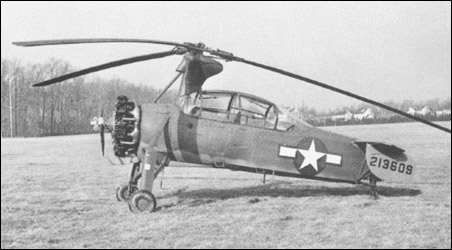The Army Air Corps liked the YG-1B but needed more power and more useful load. Above all, they wanted vertical takeoff. This was 1940 and the helicopter was not yet available. Although the Air Corps had a helicopter under construction, its usefulness was yet some time away.
Theproposed XO-60 (Kellett did not assign their own model number to the YO-60) it was a growth version of the KD-1A.
The rotor system was similar to the KD-1A, using the same type blades and familiar construction. A heat-treated 4130 steel tube was the main member, with plywood ribs and 1/32" plywood cover. Some YO-60s were flown with slightly different blades with tapered thickness and plan. These had step tapered spars and were fabric covered instead of 1/32" plywood covered. The leading edge back to the spar tube was plywood covered.
The rotor system was different with the addition of the hardware necessary for jump takeoff. The blades were set at "no lift" angle for runup. The rotor was speeded up to 280-290 rpm about 80 or 90 more than the cruise rpm. When the clutch was released a counterweight on each blade twisted the blade upward to about … degrees. Then, as the rpm bled off, the a… came back to 3 degrees. At this time, the autogiro should be at about 3 meters altitude. Reli… of its rotor load, the engine came up to … rpm and flew the YO-60 off the top … jump.
There was one problem of jumping a ta…ting autogiro. Because the tail was down rotor was tilting slightly aft. When the … did take place, the aircraft actually jumped …wards and the propeller had to overcome … bit of backward inertia before forward … could take effect.
The same rotor arrangement as YG-1 was retained, but the motion dampers that … inside the blade spars as in the KD-1/YG-l to be assisted by dampers attached from bla… blade near the root end.
The power takeoff for the rotor spinup … improved. There had been many problems … the leather faced clutch on earlier models … clutch would either slip and chatter or … release completely. When the shear pin … vertical shaft did not shear as it was suppos… damage could be done to the drive shaft.
The new style clutch had discs and used a planetary reduction gear system at the engine with a larger drive shaft running directly from the power takeoff on the engine to the rotor head.
One of the major changes put the pilot in the front seat and added a transparent plastic cover over both cockpits and a large transparent plastic panel in the belly beneath the pilot's feet. The observer's seat could swivel so he could ride backwards and work at a small table behind the rear seat. When the observer was not in place, balast had to be carried in the rear cockpit.
The long-travel Bendix shock struts were mounted nearly-vertical. The entire landing gear could be removed including the outrigger struts thus reducing the width of the fuselage for shipping from more than 2.44m to the width of the fuselage.
The engine mount, too, was removable at the firewall. In this way a quick change powerplant package could be stocked.
The fuselage structure was similar to the earlier KD-1/YG-1. The fairing was different with flatter sides giving the observer better downward vision out the side windows. The enclosure over the two cockpits hinged open and slid to the right to permit entrance and exit from the cockpits on the left.
The powerplant was a Jacobs R-915-3, seven cylinder, aircooled, radial engine providing 330hp through a Hamilton-Standard constant speed propeller.
The model was soon changed from XO-60 to YO-60 and seven were built. Only six were delivered, one was damaged in a runup accident and was not repaired. The National Air Museum in Washington has restored this autogiro for exhibit and it can be seen there along with the helicopters.
G.Townson "Autogiro. The Story of the Windmill Plane", 1985





